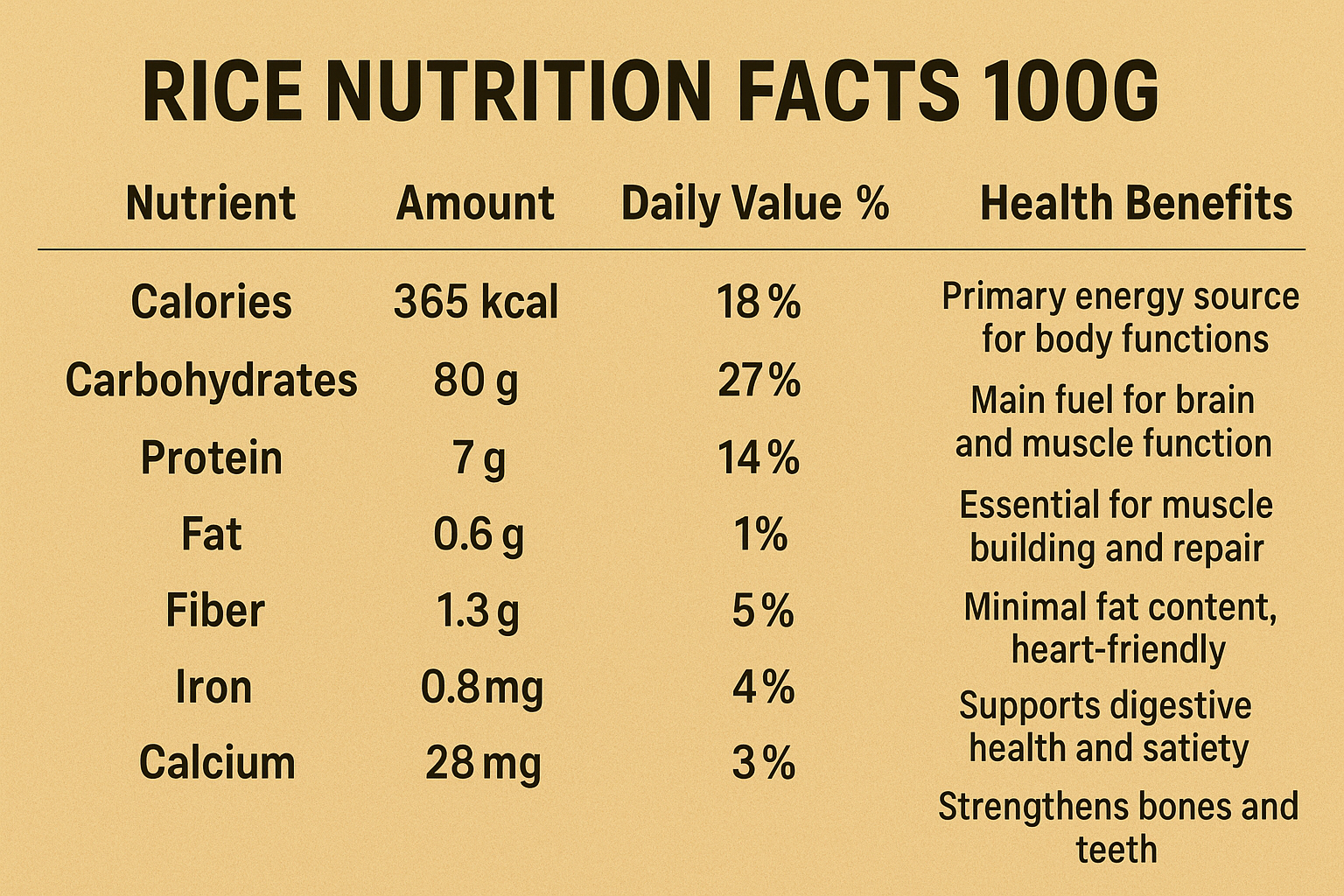
Rice Nutrition Facts 100g: Complete Nutritional Guide
amalfarm2025-09-11T11:56:58+00:00
Understanding rice nutrition facts 100g is essential for making informed and healthy dietary choices. Rice is a staple food consumed by billions of people worldwide, providing a major source of energy and nutrients. Its nutritional content, however, can vary depending on several factors—such as the type of rice (white, brown, basmati, or traditional Indian varieties), whether it is raw or cooked, and even the region and conditions in which it was grown. By knowing these details—including calories, protein, carbohydrates, fiber, vitamins, and minerals—you can plan balanced, wholesome meals that not only satisfy your hunger but also support your overall health, energy levels, and long-term wellness goals. This guide offers a comprehensive overview so you can understand how rice nutrition can change and make the best choices for your dietary needs.
Rice Nutrition Facts 100g: Raw vs Cooked – The Complete Breakdown
The nutritional content varies significantly between raw and cooked rice due to water absorption during the cooking process. When rice cooks, it absorbs water and expands, which dilutes the nutrient concentration per 100g serving.
Raw Rice Nutrition Per 100g (Uncooked)
| Nutrient | Amount | Daily Value % | Health Benefits |
|---|---|---|---|
| Calories | 365 kcal | 18% | Primary energy source for body functions |
| Carbohydrates | 80g | 27% | Main fuel for brain and muscle function |
| Protein | 7g | 14% | Essential for muscle building and repair |
| Fat | 0.6g | 1% | Minimal fat content, heart-friendly |
| Fiber | 1.3g | 5% | Supports digestive health and satiety |
| Iron | 0.8mg | 4% | Prevents anemia, supports oxygen transport |
| Calcium | 28mg | 3% | Strengthens bones and teeth |
Cooked Rice Nutrition Per 100g (Ready to Eat)
| Nutrient | White Rice | Brown Rice | Difference | Why It Matters |
|---|---|---|---|---|
| Calories | 130 kcal | 112 kcal | Brown rice has 14% fewer calories | Better for weight management |
| Carbohydrates | 28g | 23g | Brown rice has 18% fewer carbs | Lower impact on blood sugar |
| Protein | 2.7g | 2.6g | Nearly identical protein | Both provide essential amino acids |
| Fat | 0.3g | 0.9g | Brown rice has 3x more healthy fats | Contains beneficial fatty acids |
| Fiber | 0.4g | 1.8g | Brown rice has 4.5x more fiber | Better for digestion and heart health |
| Water Content | ~68% | ~70% | High water content in both | Contributes to daily hydration needs |
The difference in nutrition facts between raw and cooked rice occurs because cooked rice contains about 70% water, which significantly dilutes the nutrient concentration.
Key Nutritional Insights:
Glycemic Index and Energy Release
White rice has a high glycemic index (GI ~73), which means it causes a rapid spike in blood sugar levels. Brown rice, on the other hand, has a medium glycemic index (GI ~68) and releases energy more gradually. Its higher fiber content slows down carbohydrate absorption, making it a better option for people looking to manage blood sugar or maintain steady energy.
Protein Quality
Rice protein contains all essential amino acids, but it is relatively low in lysine. When combined with legumes such as dal, beans, or lentils, rice becomes a complete protein source—comparable to the quality of protein found in meat. This makes rice and dal a perfect traditional combination for vegetarians.
Calories in Different Rice Types (per 100g cooked)
White Rice: 130 calories
Brown Rice: 112 calories
Basmati Rice: 121 calories
Jasmine Rice: 129 calories
For portion control, keep in mind that 100g of cooked rice equals roughly half a cup or one small bowl.
Essential Vitamins and Minerals in Rice
Rice is not just about calories and carbs—it also provides important micronutrients. It contains vitamins like Thiamine (B1), Niacin (B3), Vitamin B6, and Folate, along with minerals such as Manganese, Selenium, Magnesium, and Phosphorus, all of which support energy metabolism, immunity, and bone health.
Premium Indian Rice Varieties
India is home to several traditional rice varieties with exceptional taste and nutrition:
Kalanamak Rice: Richer in protein with a unique black-tipped grain and aroma.
Gobindobhog Rice: Famous for its aromatic quality and balanced nutrition.
Katarni Rice: A traditional variety known for its flavor and wholesome nutrition.
Buying these premium varieties online ensures freshness and quality directly from authentic sources.
Conclusion
Rice nutrition facts per 100g show that rice is an excellent source of energy, offering essential carbohydrates, moderate protein, and valuable vitamins and minerals. White rice provides quick energy, while brown rice adds fiber and better blood sugar control. By understanding these differences, you can make smarter dietary choices—whether for daily meals, weight management, or overall wellness.
